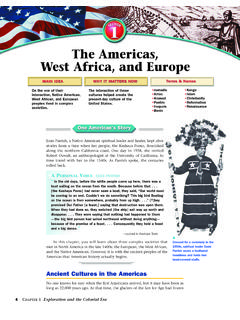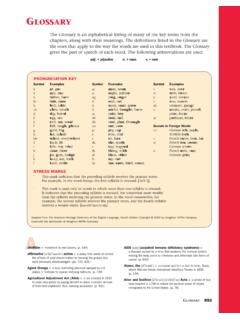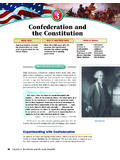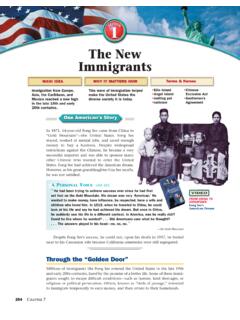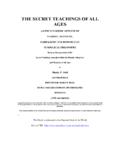Transcription of SKILLBUILDER HANDBOOK - mrlocke.com
1 Historical Main Chronological ; Causes and ; Fact from Critical Historical Historical Assumptions and Decisions and Courses of Opinions (Evaluating) Making Forming , Visual, and Technological and Secondary , Audio, Multimedia Political the Charts and Written Oral Visual PresentationsR37 SKILLBUILDERHANDBOOKR1 SKILLBUILDERHANDBOOKR10 SKILLBUILDERHANDBOOKS ection 1: Understanding Historical Making InferencesDEFINING THE SKILLM aking inferencesfrom a piece of historical writing means drawing conclusions based on facts, examples, opinions, and the author s use of language. To make inferences, use clues in the text and your own personalexperience, historical knowledge, and common THE SKILLThe following passage is from a speech by President Ronald Reagan promotinghis economic program. The chart below lists some inferences that can be drawnfrom the first TO MAKE INFERENCESS trategyFrom the facts in the text and historical knowledge,you can infer that Reagan is blaming the Democrats for the poor for clues aboutthe writer s opinion.
2 From Reagan s language and the goals of his program, you can infer that he sees government spending and taxation as a major cause of theeconomic opinionated language. You can infer from words such as exaggeratedandinaccuratethat Reagan disagreeswith criticism of his a ChartRecord clues in the text as well as what you know about the topic on the basisof your own experience, knowledge, and common THE SKILLTurn to Chapter 10, Section 3, p. 358 and read the passage headed The Impactof Territorial Gains. Create a chart like the one above, making inferencesbased on clues in the text and on your own personal experience, historicalknowledge, and common the Program for Economic RecoveryAll of us are aware of the punishing inflation which has for thefirst time in 60 years held to double-digit figures for 2 years in a rates have reached absurd levels of more than 20 percentand over 15 percent for those who would borrow to buy a home.
3 Almost 8 million Americans are out of work..I am proposing a comprehensive four-point program ..aimed at reducing the growth in government spending and taxing,reforming and eliminating regulations which are unnecessary andunproductive or counterproductive, and encouraging a consistentmonetary policy aimed at maintaining the value of the , I know that exaggerated and inaccurate stories aboutthese cuts have disturbed many people.. Those who, through nofault of their own, must depend on the rest of us the povertystricken, the disabled, the elderly, all those with true need can restassured that the social safety net of programs they depend on areexempt from any in the Text: Facts,Personal Experience,InferenceExamples, LanguageHistorical Knowledge,Reagan blames the inflation in double digitsCommon SenseDemocrats for the current Interest rates over 20% Reagan defeatedeconomic problems.
4 8 milion unemployedDemocratic incumbent Inflation is punishing Jimmy Carter in the Interest rates absurd 1980 2: Using Critical Developing Historical PerspectiveDEFINING THE SKILLH istorical perspectiveis an understanding of events and people in the context of their times. Using historical perspective can help you avoid judgingthe past solely in terms of present-day norms and THE SKILLThe following passage is the opening portion of an address by PresidentTheodore Roosevelt. Below it is a chart that summarizes the information from a historical TO DEVELOPHISTORICAL PERSPECTIVES trategyIdentify any historicalfigures, occasions, events, words, phrases,and settings that reflect the the language used by the presi-dent reflects the optimism of theProgressive how people sactions and words reflect attitudes,values, and passions of the era. HereRoosevelt equates a strong nationwith manly virtues.
5 Write a SummaryIn a chart, list key words, phrases, and details from thepassage, and then write a shortparagraph summarizing thebasic values and attitudes it THE SKILLTurn to Chapter 8, Section 2, p. 282 and read the One American s Story feature,which discusses ideas about educational reform in the late 19th century. Usehistorical perspective to summarize those ideas in a chart like the one ADDRESS, 1905 President Theodore RooseveltMy fellow-citizens, no people on earth have more cause to bethankful than ours, and this is said .. with gratitude to the Giver of Good who has blessed us with the conditions which have enabled us to achieve so large a measure of well-being andhappiness. To us as a people it has been granted to lay the foundations of our national life in a new continent. We arethe heirs of the ages, and yet we have had to pay few of thepenalties which in old countries are exacted by the dead hand ofa bygone civilization.
6 We have not been obliged to fight for ourexistence against any alien race; and yet our life has called for thevigor and effort without which the manlier and hardier virtueswither away.. [The] success which we confidently believe thefuture will bring, should cause in us no feeling of vainglory, butrather a deep and abiding realization of all which life has offeredus; a full acknowledgment of the responsibility which is ours; anda fixed determination to show that under a free government amighty people can thrive best, alike as regards the things of thebody and the things of the PhrasesAttitudesRoosevelt s Inaugural Address Giver of Good belief in GodTheodore Roosevelt reveals a strong and resilient optimism blessed us optimistic about the American nation. His confidence is grounded in heirs of the agesabout the deep religious faith in God (the Giver of Good ) and God s bygone civilizationfutureplan for the nation.
7 Roosevelt clearly believes in the ability of manlier and grateful forthe American people to solve whatever problems they face as hardier virtuesthe pastthey move into a bright future. Roosevelt s faith and appeal mighty peopleto the manly virtues reflects typical attitudes and values of things of the body the 19th- and early 20th-century things of the soulR12 SKILLBUILDERHANDBOOKS ection 2: Using Critical Formulating Historical QuestionsDEFINING THE SKILLF ormulating historical questionsentails asking questions about eventsand trends what caused them, what made them important, and so forth. Theability to formulate historical questions is an important step in doing questions will help you to guide and focus your research as well asto understand maps, graphs, and other historical THE SKILLAt a women s rights convention in the mid-1800s, the delegates adopted a Declaration of Sentiments that set forth a number of grievances.
8 The following passage is a description of that event. Below is a web diagram thatorganizes historical questions about the TO FORMULATEHISTORICAL QUESTIONSS trategyAsk about the basicfacts of the event. Who were the leaders? What did they do? Where and when did the event take place?StrategyAsk about the cause ofan event. Why did an event take place?StrategyAsk about historicalinfluences on a speaker or event. Whatother historical events was it similarto? How was it different?StrategyAsk about the resultsproduced by various causes. What were the results of the event?Make a Web DiagramUsing a web diagram, ask a broad question about the event described ask specific questions to help you explore the THE SKILLTurn to Chapter 22, Section 1, p. 734 and read the passage headed The Tonkin Gulf Resolution. Use a web diagram to write a historical questionabout the passage, as well as more specific questions that could guide your research into the Falls, 1848 Elizabeth Cady Stanton and Lucretia Mott decided to act ontheir resolution to hold a women s rights convention.
9 In 1848,more than 300 women and men convened at Seneca Falls, NewYork, the small town that gave the convention its name. Before theconvention, Stanton and Mott spent a day composing an agendaand a detailed statement of grievances. Stanton carefully modeled this Declaration of Sentiments on the Declaration of Independence. The participants approved all measures unani-mously, except for one: women s right to vote. This measure passedby a narow margin due to Stanton s insistence. The franchise forwomen, though it passed, remained a controversial happened atSeneca Falls, New York,in 1848?Who were the key people?What was the subject ofthe convention agenda?What importantmeasure was narrowlypassed?On which historicaldocument was the conventionagenda modeled?SKILLBUILDERHANDBOOKR13 Section 2: Using Critical Hypothesizing DEFINING THE SKILLH ypothesizingmeans developing a possible explanation for historical hypothesis is a tentative assumption about what happened in the past orwhat might happen in the future.
10 A hypothesis takes available information,links it to previous experience and knowledge, and comes up with a possibleexplanation, conclusion, or THE SKILLAs the Cold War came to an end, people offered various hypotheses to explainwhy the Soviet Union broke up and to predict what would replace it. Read thispassage and form your own hypothesis. Below the passage is a chart that presents a hypothesis and the facts used to support TO FORM A HYPOTHESISS trategyIdentify the events,pattern, or trend you want toexplain. Develop a hypothesis that might explain the event. Youmight hypothesize that Gorbachev snew policies would deeply affectpolitics in the Soviet Union andEastern whatfacts you have about the facts support varioushypotheses about how Gorbachev spolicies affected politics bothinside and outside the a ChartUse a chart to summarize your hypothesis about Gorbachev s reforms and thefacts that support it.

